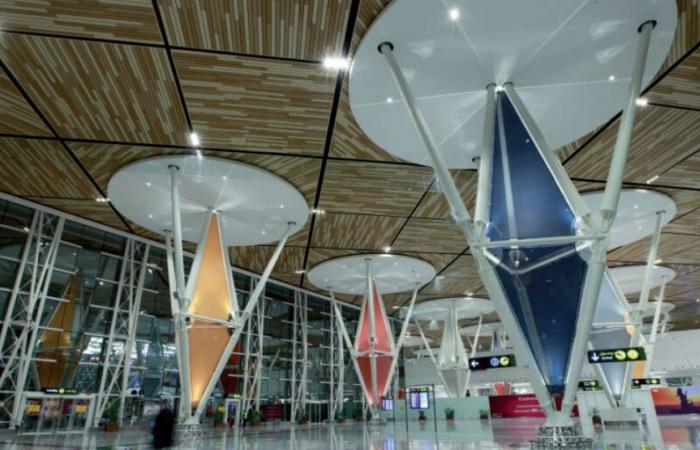The Moroccan airport network has a total of 25 airports, 19 of which are international, spread across the different regions of the Kingdom. In this dynamic context, extension work has been planned with the aim of increasing airport capacity to 80 million passengers (MPax) by 2035 compared to 40 MPax currently. An investment program of MAD 12.3 billion will be mobilized for the period 2025-2027.
After a year 2023 described as a record, especially after the post-pandemic crisis in terms of passenger traffic where Moroccan airports welcomed more than 27.1 million passengers compared to 25.1 million in 2019, air traffic begins the year 2024 with a double-digit growth rate. An increase of 19.66% at the end of October 2024 in the main Moroccan airports, rising to 24.27 million passengers during the first ten months of 2024.
In this regard, ONDA forecasts anticipate a total traffic of 30 million passengers for this year. Faced with the evolution of passenger flows and the flagship events that Morocco intends to host (African Cup and World Cup), ONDA has already increased the reception capacity of airports at horizon 2030 given that certain airports, notably Marrakech, Agadir, Tangier and Fez, have already reached, or even exceeded, their reception capacity.
In this sense, the overall capacity within these four airports will be increased to 35 million passengers per year outside of Casablanca. Remember that ONDA has already selected the engineering and consulting company, Ineco, for the development of a development program for the aeronautical infrastructure and terminals of this airport for 2040 and 2050.
A plan for 2025-2027
Currently, the Moroccan airport network has a total of 25 airports, 19 of which are international, spread across the different regions of the Kingdom. In this dynamic context, extension work has been planned with the aim of increasing the capacity of airports to 80 million passengers (MPax) by 2035 compared to 40 MPax currently. It goes without saying that the investment program is estimated at an amount of MAD 12.3 billion for the period 2025-2027 and will be dedicated, in large part, to expanding the capacities of the Mohammed V, Rabat-Salé, Marrakech, Agadir, Tetouan, Tangier, Fez and AI Hoceima.
This program will also support the growth of the tourism sector which is counting on the gradual capture of 17 million tourists in 2026 and 26 million by 2030 as well as the development plan of the RAM which has already received a Dreamliner 787 as part of of a program aiming to reach a global number of 200 devices by 2037 compared to 51 currently.
In this context, Royal Air Maroc will receive in 2025 a dozen additional aircraft, such as the 787 Dreamliner and 737 Max, all from the factories of the American aircraft manufacturer Boeing.
In detail, the reception capacity of airports will be increased, particularly in the Marrakech-Menara areas, to the tune of 11.5 million passengers/year compared to the current 5.3 MPax. Added to this are the Agadir-Al Massira enclosure (4.4 MPax/year against 1.4 MPax for an investment of 1.5 billion dirhams), Tangier-Ibn Batouta (2.3 MPax against 1.5 MPax for 2.3 billion dirhams) and Rabat-Salé (4 MPax against 5 MPax for 1.6 billion dirhams).
Extensions and redevelopments
In detail, the work to develop the aeronautical infrastructure at Marrakech-Menara airport concerns a project to extend and refit the terminal facilities of this enclosure as part of ONDA’s airport capacity development program.
This project includes the redevelopment and extension of the passenger terminal to increase its surface area to approximately 142,000 m² and the construction of road infrastructure, in particular the extension of vehicle parking on the landside. As for Agadir-Al Massira airport, the extension and redevelopment of terminal facilities project concerns the redevelopment and extension of the passenger terminal to reach a total area of approximately 75,000 m². Which includes 23,800 m² of redevelopment of the existing terminal and approximately 51,200 m² of extension in addition to exterior development, extension of the access road and vehicle parking. Added to this is the demolition and reconstruction of buildings located within the project area, while the extension of the aircraft parking lot will be spread over 47,000 m² allowing the addition of 4 medium-sized mail stations.
Regarding Tangier-Ibn Batouta, its development project includes the construction of a new passenger terminal with a total area of 70,000 m² with a central core and a pier to ensure boarding on contact. It also involves the construction of a new control tower and exterior development, the extension of the access road and vehicle parking to increase its capacity to 2,000 spaces.
For Fez-Saïss airport, the extension project includes the redevelopment and extension of the passenger terminal to reach a total area of 32,150 m² on level zero while the basement will reach an area of 13,600 m² after its extension . Added to this is the construction of road infrastructure and exterior landscaping as well as the extension of vehicle parking.
Yassine Saber / ECO Inspirations






